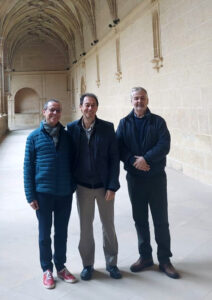Collaboration between entities involved in terminology work is consolidating as a key factor in optimising resources and enriching linguistic repertoires. This is the opinion of Jordi Bover (Termcat), Étienne Quillot (DGLFLF) and Imanol Urbieta (UZEI), who shared their views on the benefits of this cooperation for their respective organisations.
This year, Termcat, DGLFLF and UZEI have strengthened their collaboration in the field of neology. An experience that not only promotes the coherence of the methodology for the detection of neologisms, but also contributes to the optimisation of resources and to the uniformity between each of the languages concerned. We discussed the first results of this collaboration with the heads of the three organisations.
Question: What importance do you attach to collaboration between entities dedicated to terminology work?
Jordi Bover (Termcat):
Collaboration between organisations involved in terminology work makes it possible to optimise the resources invested in terminology projects because, although the organisations work in different languages, some of the research carried out may be common. We have recently seen this in the development of the Terminology of Artificial Intelligence, led by DGLFLF. The initial selection of nomenclature is valid for us and our addition of Catalan equivalents enriches the project. We have also been able to extract French equivalents from UZEI’s multilingual vocabularies on otolaryngology and ophthalmology for a project to complete medical terminology in French. On the other hand, beyond specific projects, collaboration with other organisations also allows us to share good working practices, which can help to enrich and improve our own system.
Étienne Quillot (DGLFLF):
Collaboration between terminology stakeholders –be they organisations such as DGLFLF, policy makers responsible for the terminology policy of a language, or terminology research centres and networks– is, in our view, essential. As far as DGLFLF is concerned, this collaboration is the result of a clear and long-standing political commitment. Cooperation with terminology and neology bodies in French-speaking countries and with international organisations has been enshrined in law since 1996. DGLFLF also played a key role in the creation of the Pan-Latin Terminology Network REALITER. However, beyond a willingness to cooperate, collaboration requires concrete projects and a firm commitment to demonstrate the interest and the decisive benefits it can bring to all. This is the case of the collaboration between Termcat, UZEI and DGLFLF, which can only grow and strengthen, as the first results are very promising.
Imanol Urbieta (UZEI):
At UZEI, we believe that collaboration between terminology centres in our environment is fundamental to our work. The richness and precision of a language benefit enormously from cooperation and the exchange of knowledge. This collaboration allows us to share experiences, methodologies and resources, resulting in a more coherent and consistent terminology, also for Basque. Working together also helps us to address common challenges and find innovative solutions more effectively.
Jordi Bover i Salvadó is the director of Termcat, the terminology centre whose aim is to coordinate and standardise terminology in Catalan, and whose other work includes the Neoloteca, the dictionary of neologisms in Catalan, which served as a model for the creation of our repertoire of neologisms in Basque.
Question: Could you explain how the experience of sharing neological material in this collaboration has been useful?
Jordi Bover (Termcat):
The neologisms shared by both UZEI and DGLFLF have allowed us to detect terms that we did not have in our database and to see what solutions had been found in French and Basque for terms that we had studied for Catalan. It was also very valuable for us to know, from specific documents, how the process of standardising terms for French is carried out in DGLFLF and which actors are involved in this process.
Étienne Quillot (DGLFLF):
The sharing of neologisms between our three institutions demonstrates the interest and relevance of our cooperation. On the one hand, we see that, in the technical and scientific field, when it comes to innovations, we share the same concerns and work themes, and that we often study the same concepts. It is therefore in our best interest to pool our terms and, when creating neologisms, to look for equivalent constructions, which saves time and is more efficient. On the other hand, in our case, cooperation in neology also allows us to identify concepts that need a neologism in French because we have not yet discovered them or because we have underestimated their importance. This cooperation is very fruitful, both in terms of complementarity and in terms of emulation.
Imanol Urbieta (UZEI):
The material shared by Termcat and DGLFLF during the coordination meetings on neology held over the last few months has not only allowed us to identify forms that we had not yet included in Neoloteka, but also to validate neologisms that are increasingly common in the media in each of the languages we work with.
It is true that the neologisms we have included in the Neoloteka come mainly from digital media and other web-accessible sources, and are therefore more commonly used than other technical terms, which are probably more present in the Termcat and DGLFLF repositories. However, we find this complementarity very interesting, even beyond the objectives we have set ourselves in the Neoloteka project.
Moreover, this exchange has given us the opportunity to validate and agree on new neologisms, which strengthens terminological cohesion and uniformity in different fields.
Étienne Quillot is in charge of monitoring terminology commissions and the Language Development and Enrichment Mission at the General Delegation for the French Language and the Languages of France (Délégation générale à la langue française et aux langues de France, DGLFLF) of the French Ministry of Culture.
Question: With regard to the detection of neologisms, what methodological differences or specific approaches have you noticed when incorporating these neologisms into your respective terminological repertoires?
Jordi Bover (Termcat):
We have noticed that some of the fields in which a lot of neologisms appear, such as environmental management or new technologies, are of common interest, especially with DGLFLF, which has been studying them almost simultaneously with us. In the case of the Neoloteka, the neologisms closest to the general language are of particular interest. In view of their wide impact, we thought it would be interesting to include some of these terms, which we might not have detected in our usual activity.
Étienne Quillot (DGLFLF):
For us, the identification of new concepts and the decision to study them or not is mainly based on the ‘neological intuition’ of French experts, i.e. on their knowledge of the field and on their feeling that a new concept will settle in the language over a long period of time. However, although the methods of detection and the structure of our organisations differ, the neologisms studied and published are, in the end, quite similar.
Imanol Urbieta (UZEI):
We have found that, although each entity has its own approach and methodology for detecting neologisms, there are significant similarities. In general, all entities are constantly monitoring new terms that appear in different contexts, whether in the media, in specialist literature or in everyday use. However, there may be differences in the specific criteria and processes used to evaluate and validate these neologisms.
In our case, we have chosen to focus on the actual use of neologisms, so that we only collect forms that already have a certain usage. In this sense, the Neoloteka is not a dictionary of terminological proposals, but a collection of usage examples from the current corpus. We are also compiling the first entries of which we are aware.
Question: Do you think the current criteria and procedures for including neologisms are valid or sufficient?
Jordi Bover (Termcat):
In the case of Termcat, neologisms are detected in several ways. A very important one comes from our Query Service, which receives around 2,000 queries a year, generating more than 500 new terms. The compilation of sectoral dictionaries also allows us to identify many terminological gaps. We have recently introduced another more proactive means of detection, based on the terminological extraction from high-impact scientific publications, which makes it possible to locate highly specialised and recently introduced neologisms. These are undoubtedly valid mechanisms, but they could be extended in the future with a more systematic search of specialised reference sources using artificial intelligence tools. It could be even more efficient, and indeed we have already begun to work in this direction, to detect future neologisms in our language in English sources, in order to propose alternatives before incorrect names or borrowings from English begin to circulate.
Étienne Quillot (DGLFLF):
The System for the Enrichment of the French Language, coordinated by DGLFLF, pays particular attention to the clarity of the terms it recommends in relation to the concept they refer to (the entry must be consistent with the definition), to their consistency with previously published terms and, finally, to their conformity with the morphological and syntactic system of the French language. For this reason, it sometimes chooses to create new terms rather than to ratify terms that are already in use but that it considers to be unclear or poorly formed. The criterion of conformity with the French morphological and syntactic system is also sometimes an obstacle to the neological inventiveness that we sometimes envy in the neological creations of Catalan and Basque. However, if we compare the structure of the terms proposed in our three languages, it is quite similar and only differs as much as that between French in France and French in Quebec, where there are variations linked mainly to the socio-cultural context.
There is no doubt that we can learn from our partners and draw further inspiration from the successful implementation of the terms they have proposed.
Imanol Urbieta (UZEI):
In general, we believe that the criteria we use are effective for the sociolinguistic reality of the Basque language. However, there is always room for improvement. It is important to maintain a balance between flexibility and rigour, so that new terms are relevant and useful without losing precision or coherence.
In particular, the fact that only the forms that are actually used are included sometimes means that in the Neoloteka, more common neologisms coexist with other less documented forms that would be more appropriate from the point of view of technical and scientific accuracy. In any case, they all have their place in Neoloteka.

